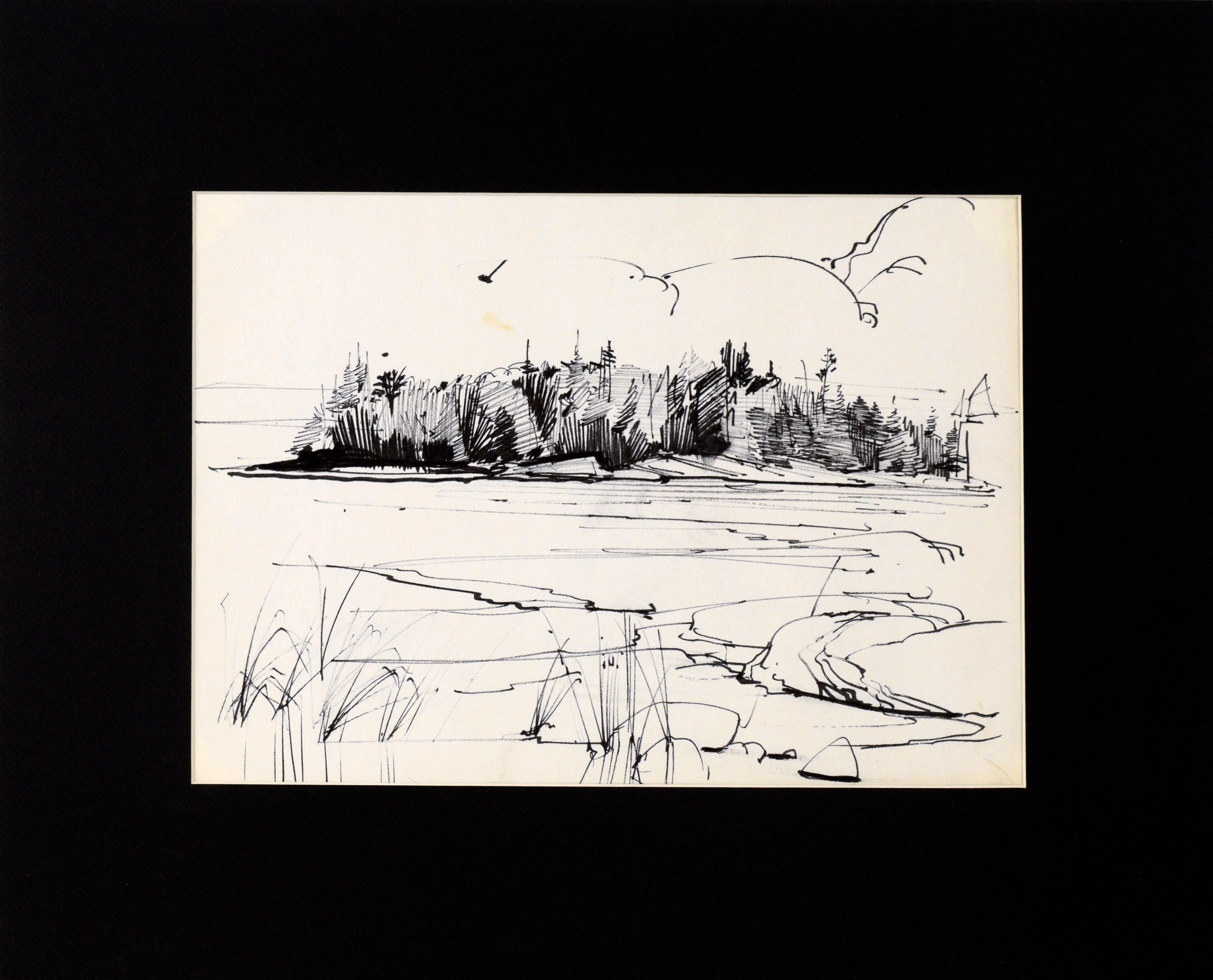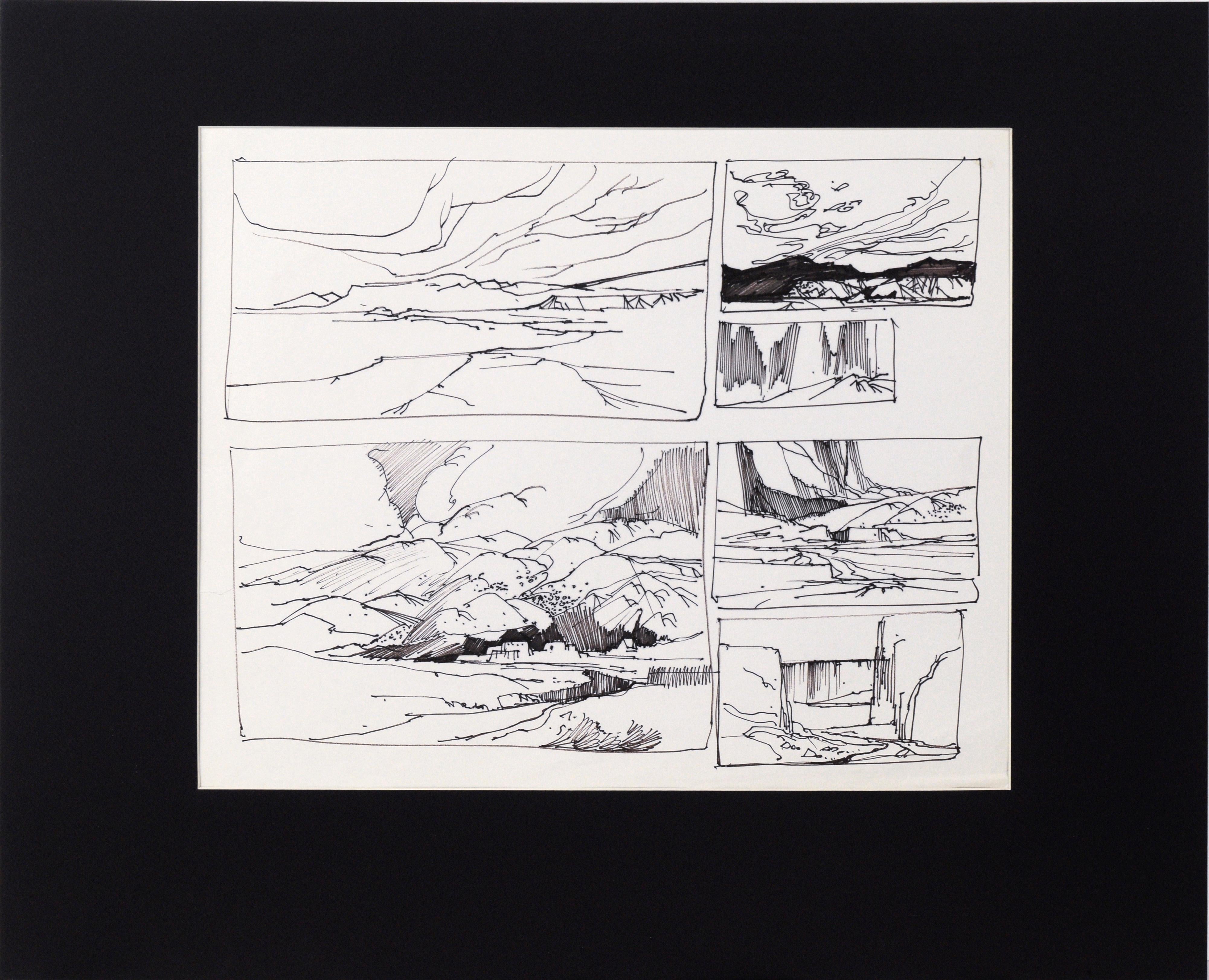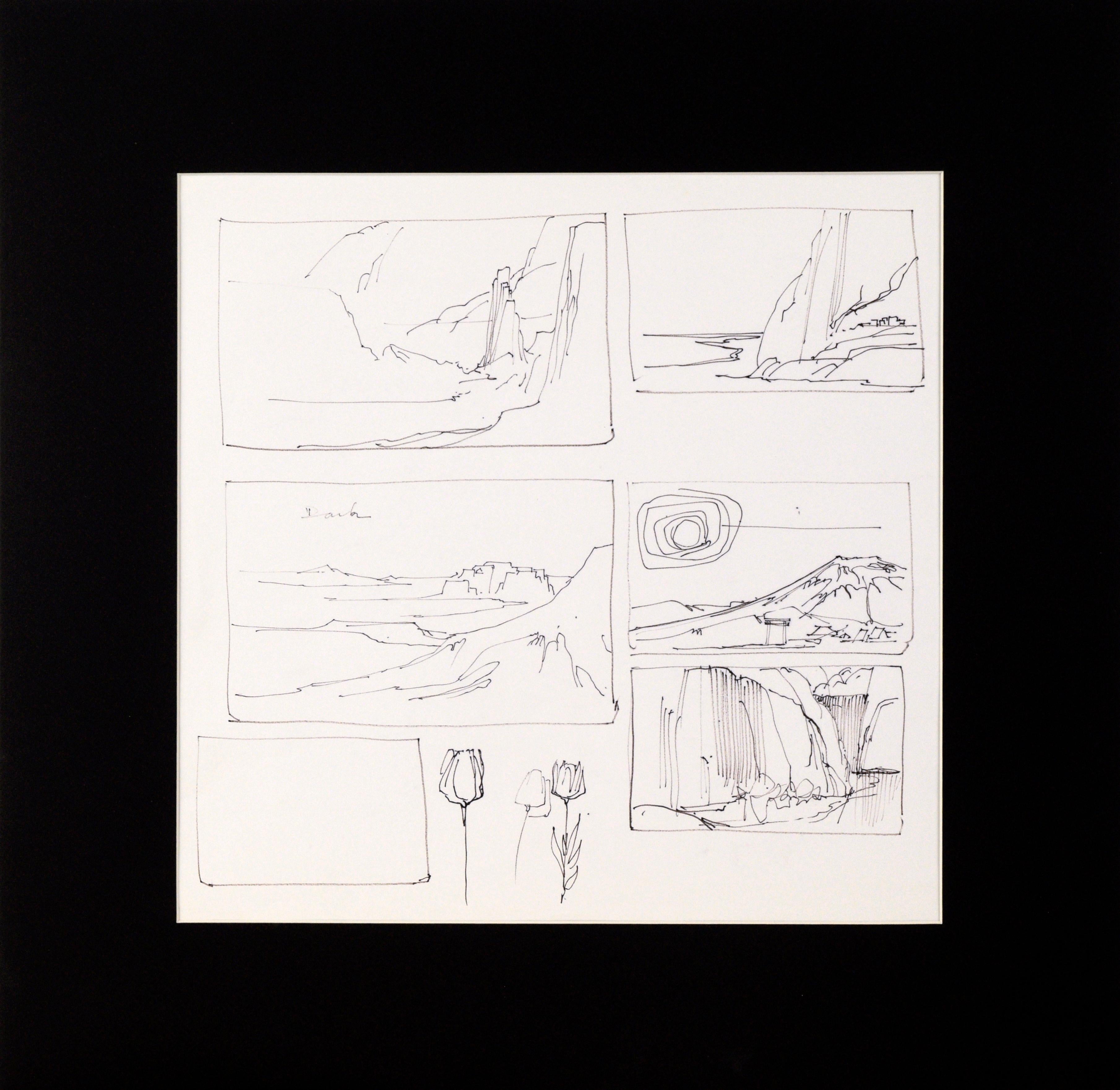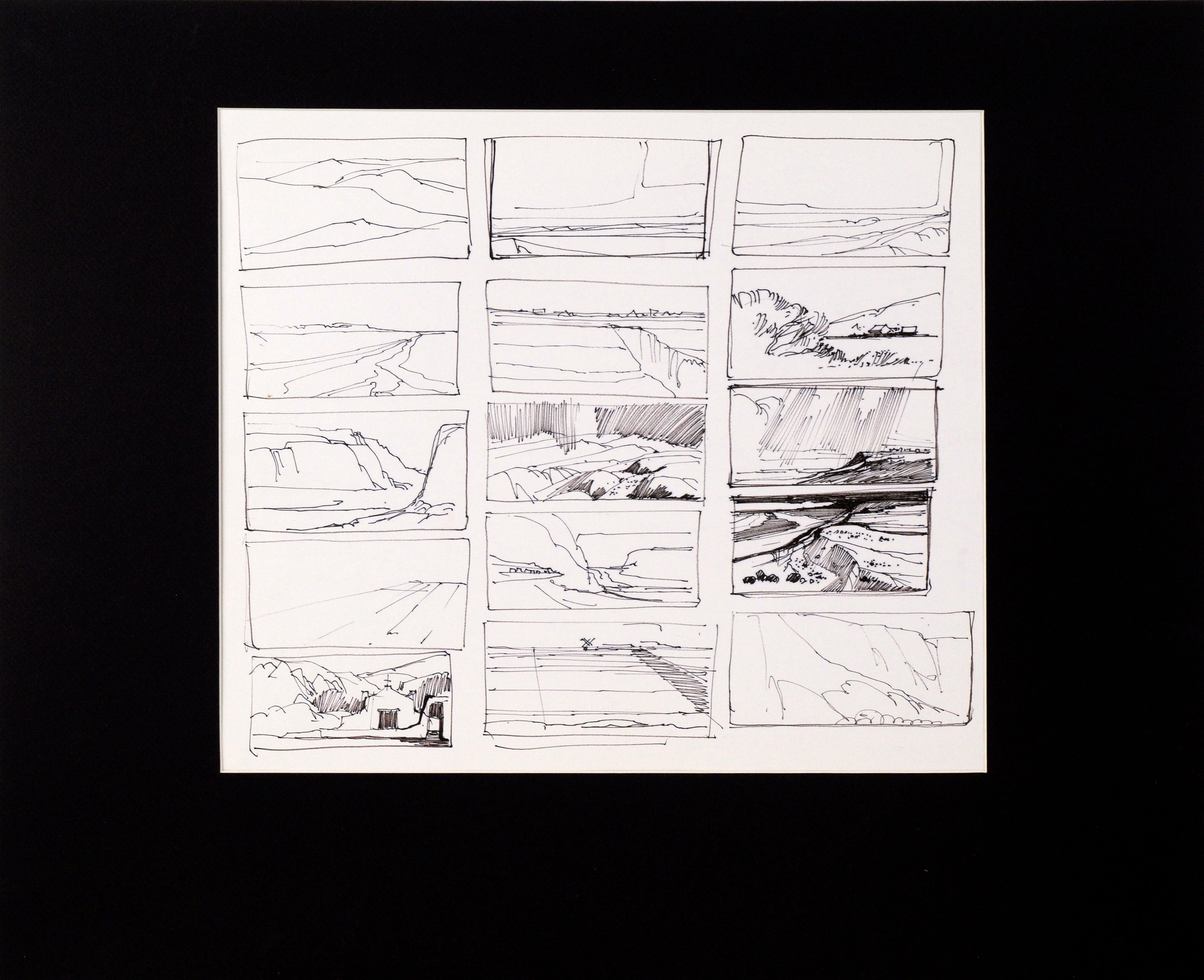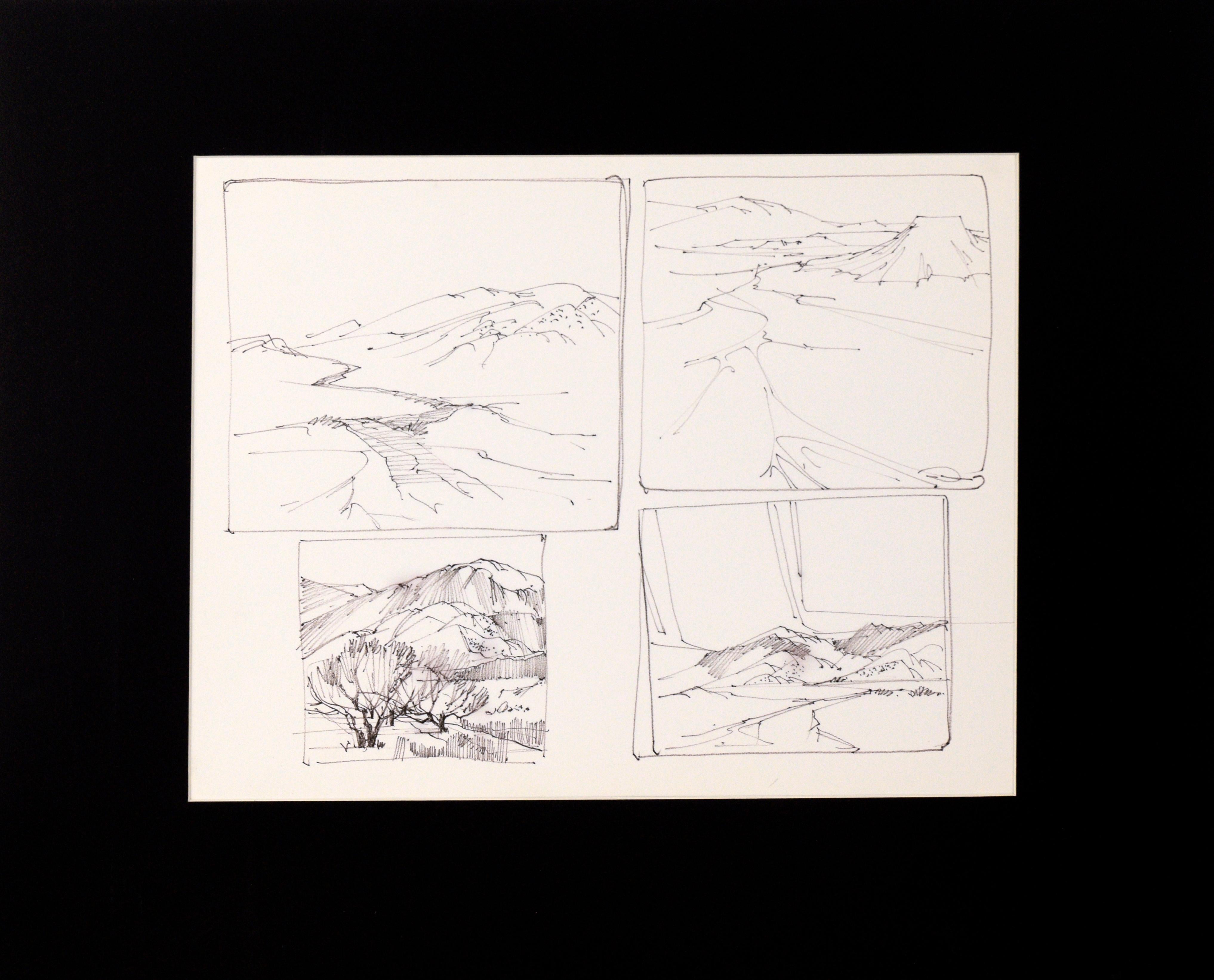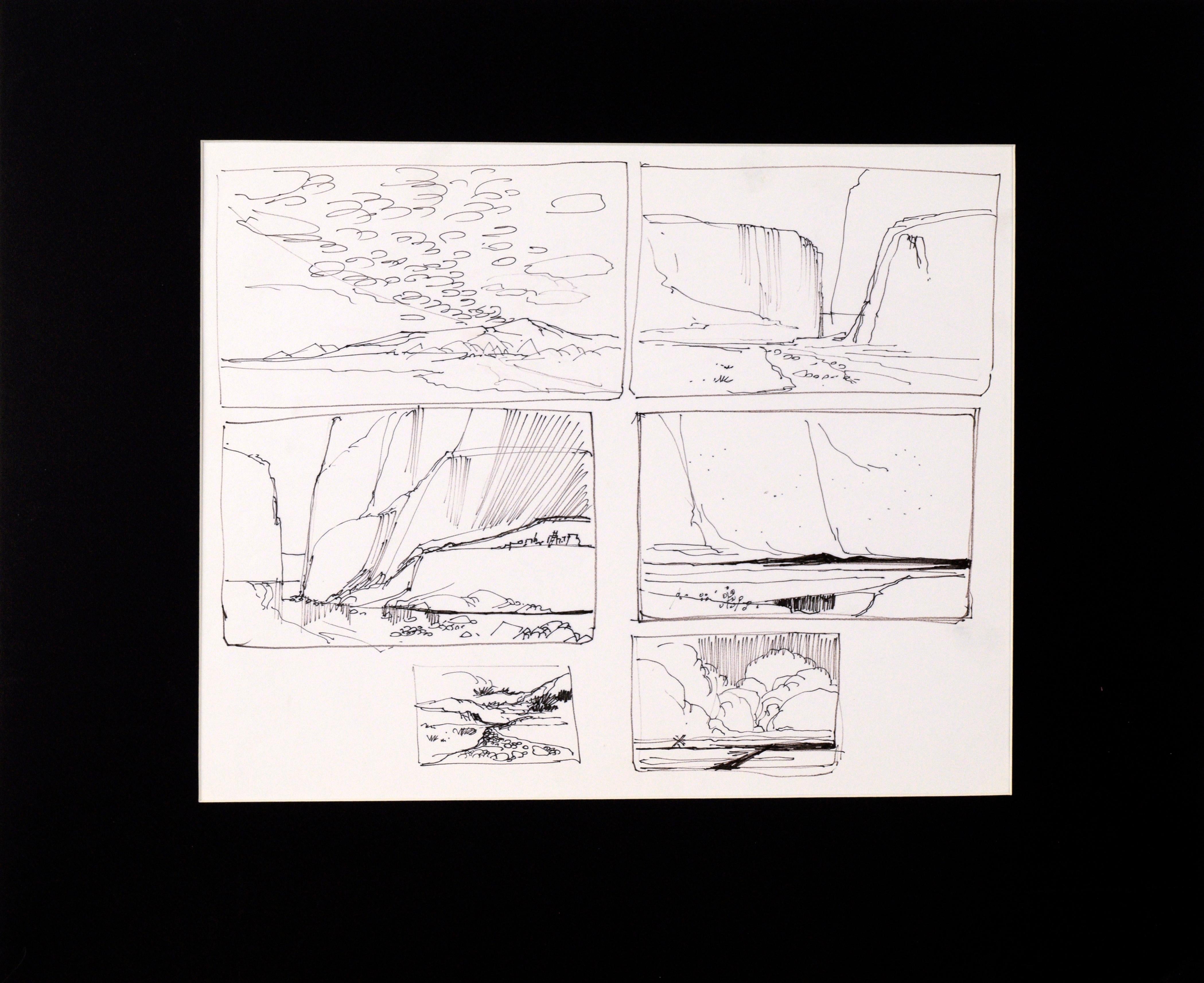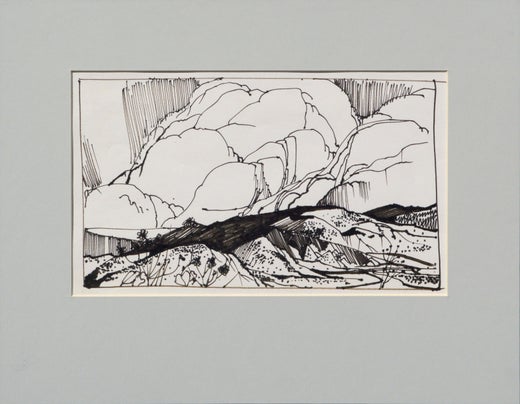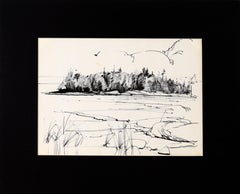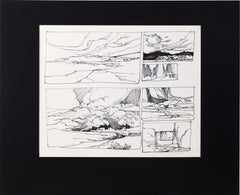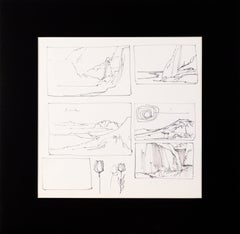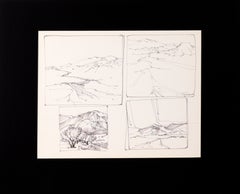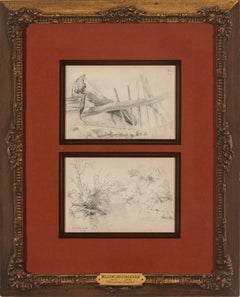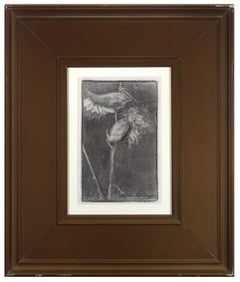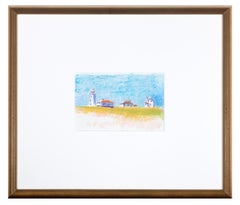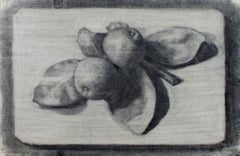Items Similar to Snow-Capped Mountain Lake - Line Drawing Landscape in Ink on Paper
Want more images or videos?
Request additional images or videos from the seller
1 of 6
Laurence SissonSnow-Capped Mountain Lake - Line Drawing Landscape in Ink on Paperlate 20th Century
late 20th Century
About the Item
Snow-Capped Mountain Lake - Line Drawing Landscape in Ink on Paper
Bold landscape line drawing by listed Maine artist Laurence Sisson (American, 1928-2015). A snow-capped mountain stands above a lake with a tree in the foreground. This drawing was likely a preparatory sketch for a larger painting.
This piece is unsigned, but was acquired from David Sisson, the artist's son.
Letter of authentication included.
Presented in a new black mat with foam-core backing.
Mat size: 8"H x 10"W
Image size: 3"H x 6.63"W
Laurence Sisson, was a student of Herbert Barnett (1910-1972), he was one of America's preeminent realist painters today. His work may be found in the permanent collections of museums nationwide including the Museum of Fine Arts, Boston, and the Portland Museum of Art, Maine.
Laurence Sisson painted landscapes for sixty years. He was known for his paintings of the Maine coast and landscapes of the southwest. His style ranges from plein air watercolors to large oil landscapes with abstract and surrealist elements. Laurence Sisson spent 50 years living in both areas of the United States yet he notes the most influential place for his artistic development was the time he spent in Japan as a young man.
Laurence Sisson was been a talented painter as a child and attended art classes at the Worcester Art museum in Massachusetts. Sisson painted professionally while in his early twenties though he had not decided to devote his life to art. While serving in the military during the United States occupation of Japan after War World II he was assigned to decorate the general's residence in Yokohama. This assignment forced him to learn all he could about the land and culture of Japan and by the time he left he was changed as an artist and man.
Sisson describes this period of his painting as when he began "designing nature." His work appears to be a response to traditional Asian landscape painting, his Yankee sensibility and western art training at Yale summer school. His landscapes of both Maine and the southwest are inspired by real locations, but are in fact imaginary landscapes.
Sisson was the youngest member of the Watercolor Society of America.
- Creator:Laurence Sisson (1928, American)
- Creation Year:late 20th Century
- Dimensions:Height: 8 in (20.32 cm)Width: 10 in (25.4 cm)Depth: 0.25 in (6.35 mm)
- Medium:
- Movement & Style:
- Period:
- Condition:Overall, very good condition. Mat is new.
- Gallery Location:Soquel, CA
- Reference Number:Seller: ANS85681stDibs: LU54212210342
Laurence Sisson
Laurence Sisson, was a student of Herbert Barnett (1910-1972), he was one of America's preeminent realist painters today. His work may be found in the permanent collections of museums nationwide including the Museum of Fine Arts, Boston, and the Portland Museum of Art, Maine. Laurence Sisson painted landscapes for sixty years. He was known for his paintings of the Maine coast and landscapes of the southwest. His style ranges from plein air watercolors to large oil landscapes with abstract and surrealist elements. Laurence Sisson spent 50 years living in both areas of the United States yet he notes the most influential place for his artistic development was the time he spent in Japan as a young man. Laurence Sisson was been a talented painter as a child and attended art classes at the Worcester Art museum in Massachusetts. Sisson painted professionally while in his early twenties though he had not decided to devote his life to art. While serving in the military during the United States occupation of Japan after War World II he was assigned to decorate the general's residence in Yokohama. This assignment forced him to learn all he could about the land and culture of Japan and by the time he left he was changed as an artist and man. Sisson describes this period of his painting as when he began "designing nature." His work appears to be a response to traditional Asian landscape painting, his Yankee sensibility and western art training at Yale summer school. His landscapes of both Maine and the southwest are inspired by real locations, but are in fact imaginary landscapes. Sisson was the youngest member of the Watercolor Society of America.
About the Seller
5.0
Platinum Seller
Premium sellers with a 4.7+ rating and 24-hour response times
Established in 1986
1stDibs seller since 2014
2,913 sales on 1stDibs
Typical response time: <1 hour
- ShippingRetrieving quote...Shipping from: Soquel, CA
- Return Policy
Authenticity Guarantee
In the unlikely event there’s an issue with an item’s authenticity, contact us within 1 year for a full refund. DetailsMoney-Back Guarantee
If your item is not as described, is damaged in transit, or does not arrive, contact us within 7 days for a full refund. Details24-Hour Cancellation
You have a 24-hour grace period in which to reconsider your purchase, with no questions asked.Vetted Professional Sellers
Our world-class sellers must adhere to strict standards for service and quality, maintaining the integrity of our listings.Price-Match Guarantee
If you find that a seller listed the same item for a lower price elsewhere, we’ll match it.Trusted Global Delivery
Our best-in-class carrier network provides specialized shipping options worldwide, including custom delivery.More From This Seller
View AllIsland Forest - Line Drawing Landscape in Ink on Paper
By Laurence Sisson
Located in Soquel, CA
Island Forest - Line Drawing Landscape in Ink on Paper
Delicate landscape line drawing by listed Maine artist, Laurence Sisson (American, 1928-...
Category
Late 20th Century American Impressionist Landscape Drawings and Watercolors
Materials
Paper, Permanent Marker
Six Panel Thumbnail Sketches of Desert and Canyon Landscapes in Ink on Paper
By Laurence Sisson
Located in Soquel, CA
Six Panel Thumbnail Sketches of Desert and Canyon Landscapes in Ink on Paper
Collection of landscape line drawings by listed Maine artist Laurence Sisson (American, 1928-2015). Six ...
Category
Late 20th Century American Impressionist Landscape Drawings and Watercolors
Materials
Paper, Permanent Marker
Five-Panel Thumbnail Sketches of Desert and Canyon Landscapes in Ink on Paper
By Laurence Sisson
Located in Soquel, CA
Five-Panel Thumbnail Sketches of Desert and Canyon Landscapes in Ink on Paper
Collection of landscape line drawings by listed Maine artist Laurence Sisson (American, 1928-2015). Fiv...
Category
Late 20th Century American Impressionist Landscape Drawings and Watercolors
Materials
Paper, Permanent Marker
Four-Panel Thumbnail Sketches of Desert and Canyon Landscapes in Ink on Paper
By Laurence Sisson
Located in Soquel, CA
Four-Panel Thumbnail Sketches of Desert and Canyon Landscapes in Ink on Paper
Collection of landscape line drawings by listed Maine artist Laurence Sisson (American, 1928-2015). Fou...
Category
Late 20th Century American Impressionist Landscape Drawings and Watercolors
Materials
Paper, Permanent Marker
Fifteen-Panel Thumbnail Sketches of Desert and Canyon Landscapes in Ink on Paper
By Laurence Sisson
Located in Soquel, CA
Fifteen-Panel Thumbnail Sketches of Desert and Canyon Landscapes in Ink on Paper
Collection of landscape line drawings by listed Maine artist Laurence Sisson (American, 1928-2015). ...
Category
Late 20th Century American Impressionist Landscape Drawings and Watercolors
Materials
Paper, Permanent Marker
Six-Panel Thumbnail Sketches of Desert and Canyon Landscapes in Ink on Paper
By Laurence Sisson
Located in Soquel, CA
Six-Panel Thumbnail Sketches of Desert and Canyon Landscapes in Ink on Paper
Collection of landscape line drawings by listed Maine artist Laurence Sisson (American, 1928-2015). Six ...
Category
Late 20th Century American Impressionist Landscape Drawings and Watercolors
Materials
Paper, Permanent Marker
You May Also Like
"Central Park"
By William Langson Lathrop
Located in Lambertville, NJ
Jim’s of Lambertville is proud to offer this artwork.
Signed. Complemented by a hand carved and gilt frame.
William L. Lathrop (1859-1938)
Deemed “Father of the New Hope Art Colony”, William Langson Lathrop was born in Warren, Illinois. He was largely self-taught, having only studied briefly with William Merritt Chase in 1887, at the Art Students League. Lathrop first moved east in the early 1880s, and took a job at the Photoengraving Company in New York City. While there, he befriended a fellow employee, Henry B. Snell. The two men became lifelong friends and ultimately, both would be considered central figures among the New Hope Art Colony.
Lathrop's early years as an artist were ones of continuing struggle. His efforts to break through in the New York art scene seemed futile, so he scraped enough money together to travel to Europe with Henry Snell in1888. There he met and married an English girl, Annie Burt. Upon returning to New York, he tried his hand at etching, making tools from old saw blades. Even though his prints were extremely beautiful, he still was impoverished. Lathrop would return to his family in Ohio, before once again attempting the New York art scene. In 1899, with great trepidation, he submitted five small watercolors to an exhibit at the New York Watercolor Club. He won the Evans Prize, the only award given, and four of the five paintings were sold the opening night. At age forty Lathrop’s career would finally take off and he became an “overnight success
Lathrop came to Phillips Mill for the first time in1898, to visit his boyhood friend, Dr. George Marshall. Shortly after, he and his family purchased the old miller’s house from Dr. Marshall. The Lathrop’s home became a social and artistic center for the growing New Hope colony. Tea and fascinating conversation was the “order of the day” every Sunday. This was a scene fondly recalled by many younger art students that Lathrop taught privately at Phillips Mill. It was common to see groups of his students painting and sketching along the banks of the canal or aboard his canal boat. He had previously taught in the Poconos and at the Lyme, Connecticut Summer School in1907, but Phillips Mill always remained Lathrop’s permanent address.
In 1928, a committee headed by Lathrop was formed to purchase the old Phillips Mill building as a place to hold community gatherings and art exhibitions. The committee had success and in 1929 the Phillips Mill Community Association was formed. This became the center of the New Hope Art Colony holding annual exhibitions and still operating today.
In 1930, Lathrop had built a sailboat he named the “Widge”. For eight consecutive seasons he sailed it along the coast of Long Island...
Category
Early 20th Century American Impressionist Landscape Drawings and Waterco...
Materials
Paper, Graphite
"Milkweed Pod I #528" Original Charcoal Drawing
By Sylvia Spicuzza
Located in Milwaukee, WI
In this drawing, Sylvia Spicuzza presents the viewer with a dark, subtle view of two milkweed pods, bursting forth with cotton. Examples like this show the ability of Spicuzza to draw in a naturalistic style, where most of her work is usually in a highly stylized, graphic mode. The richness and depth of the black charcoal makes for a moody image.
8 x 5 inches, artwork
18 x 14.5 inches, frame
Born in 1908, Sylvia Spicuzza was the daughter of noted painter Francesco Spicuzza. Sylvia devoted herself to teaching art to the students of Lake Bluff...
Category
1920s American Impressionist Figurative Drawings and Watercolors
Materials
Paper, Charcoal
Machias Seal Island Light
By Wolf Kahn
Located in Milwaukee, WI
Wolf Kahn was commissioned by the Smithsonian to design a postcard for them. He made four designs and they selected a singular one. This drawing here is one of the few rejected designs. This piece was given to the founder, David Barnett, of the David Barnett Gallery...
Category
19th Century American Impressionist Landscape Drawings and Watercolors
Materials
Paper, Pastel
"Still Life with Fruit" original charcoal drawing by Sylvia Spicuzza
By Sylvia Spicuzza
Located in Milwaukee, WI
In this drawing, Sylvia Spicuzza presents the viewer with a dark, subtle view of two apples, still clinging to their leaves. Examples like this show the ability of Spicuzza to draw i...
Category
1920s American Impressionist Figurative Drawings and Watercolors
Materials
Paper, Charcoal
"Moroccan Market" Emily Sargent, Luminous Bazaar, Impressionist Landscape
Located in New York, NY
Emily Sargent
Moroccan Market, circa 1900
Watercolor on paper
9 1/2 x 13 1/2 inches
Provenance
The artist
Family of the artist by descent
Adelson Galleries Inc., New York
Collection...
Category
Early 1900s American Impressionist Figurative Drawings and Watercolors
Materials
Paper, Watercolor
"Train Station, " Max Kuehne, Industrial City Scene, American Impressionism
By Max Kuehne
Located in New York, NY
Max Kuehne (1880 - 1968)
Train Station, circa 1910
Watercolor on paper
8 1/4 x 10 1/4 inches
Signed lower right
Provenance:
Private Collection, Illinois
Max Kuehne was born in Halle, Germany on November 7, 1880. During his adolescence the family immigrated to America and settled in Flushing, New York. As a young man, Max was active in rowing events, bicycle racing, swimming and sailing. After experimenting with various occupations, Kuehne decided to study art, which led him to William Merritt Chase's famous school in New York; he was trained by Chase himself, then by Kenneth Hayes Miller. Chase was at the peak of his career, and his portraits were especially in demand. Kuehne would have profited from Chase's invaluable lessons in technique, as well as his inspirational personality. Miller, only four years older than Kuehne, was another of the many artists to benefit from Chase's teachings. Even though Miller still would have been under the spell of Chase upon Kuehne's arrival, he was already experimenting with an aestheticism that went beyond Chase's realism and virtuosity of the brush. Later Miller developed a style dependent upon volumetric figures that recall Italian Renaissance prototypes.
Kuehne moved from Miller to Robert Henri in 1909. Rockwell Kent, who also studied under Chase, Miller, and Henri, expressed what he felt were their respective contributions: "As Chase had taught us to use our eyes, and Henri to enlist our hearts, Miller called on us to use our heads." (Rockwell Kent, It's Me O Lord: The Autobiography of Rockwell Kent. New York: Dodd, Mead and Co., 1955, p. 83). Henri prompted Kuehne to search out the unvarnished realities of urban living; a notable portion of Henri's stylistic formula was incorporated into his work.
Having received such a thorough foundation in art, Kuehne spent a year in Europe's major art museums to study techniques of the old masters. His son Richard named Ernest Lawson as one of Max Kuehne's European traveling companions. In 1911 Kuehne moved to New York where he maintained a studio and painted everyday scenes around him, using the rather Manet-like, dark palette of Henri.
A trip to Gloucester during the following summer engendered a brighter palette. In the words of Gallatin (1924, p. 60), during that summer Kuehne "executed some of his most successful pictures, paintings full of sunlight . . . revealing the fact that he was becoming a colorist of considerable distinction." Kuehne was away in England the year of the Armory Show (1913), where he worked on powerful, painterly seascapes on the rocky shores of Cornwall. Possibly inspired by Henri - who had discovered Madrid in 1900 then took classes there in 1906, 1908 and 1912 - Kuehne visited Spain in 1914; in all, he would spend three years there, maintaining a studio in Granada. He developed his own impressionism and a greater simplicity while in Spain, under the influence of the brilliant Mediterranean light. George Bellows convinced Kuehne to spend the summer of 1919 in Rockport, Maine (near Camden). The influence of Bellows was more than casual; he would have intensified Kuehne's commitment to paint life "in the raw" around him.
After another brief trip to Spain in 1920, Kuehne went to the other Rockport (Cape Ann, Massachusetts) where he was accepted as a member of the vigorous art colony, spearheaded by Aldro T. Hibbard. Rockport's picturesque ambiance fulfilled the needs of an artist-sailor: as a writer in the Gloucester Daily Times explained, "Max Kuehne came to Rockport to paint, but he stayed to sail." The 1920s was a boom decade for Cape Ann, as it was for the rest of the nation. Kuehne's studio in Rockport was formerly occupied by Jonas Lie.
Kuehne spent the summer of 1923 in Paris, where in July, André Breton started a brawl as the curtain went up on a play by his rival Tristan Tzara; the event signified the demise of the Dada movement. Kuehne could not relate to this avant-garde art but was apparently influenced by more traditional painters — the Fauves, Nabis, and painters such as Bonnard. Gallatin perceived a looser handling and more brilliant color in the pictures Kuehne brought back to the States in the fall. In 1926, Kuehne won the First Honorable Mention at the Carnegie Institute, and he re-exhibited there, for example, in 1937 (Before the Wind). Besides painting, Kuehne did sculpture, decorative screens, and furniture work with carved and gilded molding. In addition, he designed and carved his own frames, and John Taylor Adams encouraged Kuehne to execute etchings. Through his talents in all these media he was able to survive the Depression, and during the 1940s and 1950s these activities almost eclipsed his easel painting. In later years, Kuehne's landscapes and still-lifes show the influence of Cézanne and Bonnard, and his style changed radically.
Max Kuehne died in 1968. He exhibited his work at the National Academy of Design, the Art Institute of Chicago, the Carnegie Institute in Pittsburgh, the Memorial Art Gallery of the University of Rochester, and in various New York City galleries. Kuehne's works are in the following public collections: the Detroit Institute of Arts (Marine Headland), the Whitney Museum (Diamond Hill...
Category
1910s American Impressionist Landscape Drawings and Watercolors
Materials
Paper, Watercolor
Recently Viewed
View AllMore Ways To Browse
Line Drawings
Large Landscape Drawing
Mountain Drawing
Line Drawing Landscape
Air Line
Ink Line Painting
Drawing Lake
Mountain Lake
Snow And Trees
Caps Painting
Snow Mountain Art
Snow Mountain Painting
Summer At The Lake
Oil Snow And Trees Landscape
Oil Painting Snow And Mountains
Caps Change
Japanese Snow Painting
Maine Mountains
